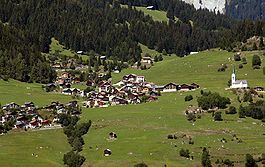Ladir
| Ladir | ||
|---|---|---|
| Former municipality of Switzerland | ||
 |
||
|
||
| Coordinates: 46°47′N 9°12′E / 46.783°N 9.200°ECoordinates: 46°47′N 9°12′E / 46.783°N 9.200°E | ||
| Country | Switzerland | |
| Canton | Graubünden | |
| District | Surselva | |
| Area | ||
| • Total | 7.21 km2 (2.78 sq mi) | |
| Elevation | 1,276 m (4,186 ft) | |
| Population (Dec 2011) | ||
| • Total | 115 | |
| • Density | 16/km2 (41/sq mi) | |
| Postal code | 7155 | |
| SFOS number | 3576 | |
| Surrounded by | Falera, Ruschein, Schluein, Schnaus | |
| Website |
www SFSO statistics |
|
Ladir is a former municipality in the district of Surselva in the Swiss canton of Graubünden. On 1 January 2014 the former municipalities of Ladir, Castrisch, Ilanz, Luven, Pitasch, Riein, Ruschein, Schnaus, Sevgein, Duvin, Pigniu, Rueun and Siat merged into the new municipality of Ilanz/Glion.
Ladir is first mentioned about 850 as Leitura.
Before the merger, Ladir had a total area of 7.2 km2 (2.8 sq mi). Of this area, 50.3% is used for agricultural purposes, while 42.2% is forested. Of the rest of the land, 2.6% is settled (buildings or roads) and the remainder (4.9%) is non-productive (rivers, glaciers or mountains).
The former municipality is located in the Ilanz sub-district of the Surselva district. Before 2000, it was part of the Glenner district. It is located in the heights of the northern flank of the "Gruob" also known as the Ilanz area. It consists of the village of Ladir and the exclave alpine settlement of Dadens da Ladir on the Crap Masegn mountain. The municipality does actually not reach the plain in the valley nor the banks of river Rhine. The Senda Sursilvana multiday hiking trail passes the village as it follows the northern flank of the Vorderrhein through Falera and Siat, continuing towards Panix.
Ladir had a population (as of 2011) of 115. As of 2008[update], 9.7% of the population was made up of foreign nationals. Over the last 10 years the population has decreased at a rate of 0%. Most of the population (as of 2000[update]) speaks Romansh(57.0%), with German being second most common (41.1%) and French being third ( 1.9%).
...
Wikipedia




